Sforza Castle, in Italian Castello Sforzesco, is a journey back in time, right in the heart of Milan. With its Renaissance courtyards, fascinating museums, and remarkable artworks. Among all, you can see Michelangelo’s final masterpiece, the Pietà Rondanini, but every corner of the Castle has a story to tell. It’s one of those landmarks you can visit over and over again, always discovering something new and unexpected.
Table of Contents
Sforza Castle in Milan: Origins and Tumultuous History
With over seven centuries of history, Sforza Castle tells the story of Milan better than a thousand words. Walking along its ancient walls, you can travel through time, from medieval battles to the splendour of the Renaissance and even the struggles for independence.
PLAN YOUR TRIP TO MILAN
Before you go, buy the Milan Official City Pass online to enter the city’s top museums, including the Pinacoteca Ambrosiana, the Science and Technology Museum, and the Triennale. It also grants you access to the Duomo terraces and free rides on trams, buses, and the metro lines.
If you’re travelling with children or short on time, book in advance the hop-on hop-off sightseeing bus tickets with audio guide to see Milan in one day, stopping at main attractions like Brera, the Duomo, Galleria Vittorio Emanuele II, and La Scala Theatre.
While travelling in Italy, you can stay connected with family and friends using Holafly eSIM, enjoying unlimited data at 3G, 4G, and LTE speeds. Additionally, don’t forget to get Heymondo travel insurance for worry-free adventures.
Originally built in the 14th century by Galeazzo II Visconti as a military fortress, the Castle was later transformed into a refined Renaissance residence by Francesco Sforza. Under his rule, it became one of the most sophisticated courts in Europe, attracting artists like Leonardo da Vinci and Bramante.
From Fortress to Cultural Treasure
Over the centuries, Sforza Castle witnessed foreign domination and political turmoil. It evolved from a ducal palace into a Spanish fortress, an Austrian barracks, a prison during the Five Days of Milan, and even a stable under Napoleon.
For a long time, the Castle was seen as a symbol of oppression. In fact, it was looted and damaged multiple times by the Milanese themselves. It wasn’t until after Italian unification that the Castle began to be appreciated again.
Restored at the end of the 19th century, it was given back to the city as a cultural and museum hub, preserving Lombardy’s rich historical and artistic heritage. Today, Sforza Castle welcomes visitors worldwide with its grand courtyards, frescoed rooms, and fascinating museums.
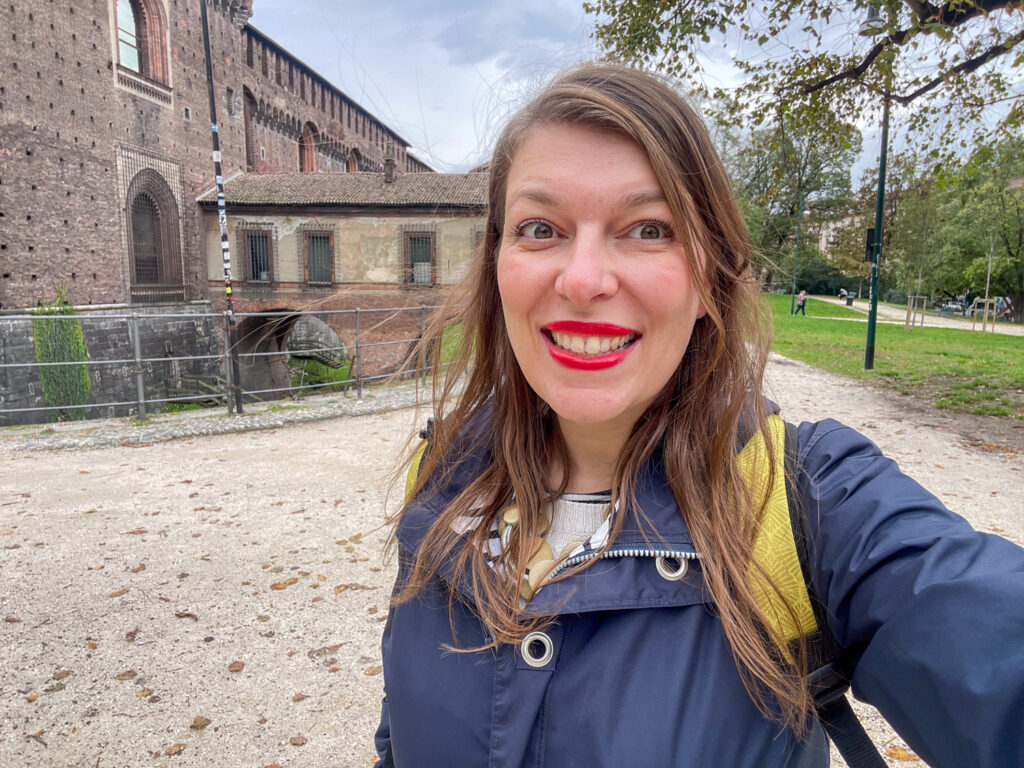
What to See Inside Sforza Castle: a Complete Guide to the Must-Visit Highlights
Inside Sforza Castle, you’ll find a treasure trove of art masterpieces housed in its museums, including Michelangelo’s final sculpture, the Pietà Rondanini, and frescoes by Leonardo da Vinci.
But the Castle isn’t just about museums. You can also visit its towers, walk through Renaissance courtyards, and explore the rooms once used by the Sforza dukes. Every corner tells a story, so slow down and soak up centuries of history and culture.
The Courtyards of Sforza Castle: an Open-Air Museum in the Heart of Milan
You can dive into Milan’s history and art even without stepping inside the museums of Sforza Castle. In the Castle’s courtyards you can see many statues, fragments of ancient architecture, and archaeological remains. Terracotta reliefs, coats of arms, and old inscriptions invite you to uncover the city’s past.
Entering through the Filarete Tower, you’ll find yourself in the vast Cortile delle Armi. This courtyard hosts Roman sarcophagi and remnants of Renaissance statues. Just ahead is the Spanish Hospital, once used as an infirmary for the Castle’s soldiers during the Spanish rule. Nearby, you can spot the medieval moat with the statue of Saint John of Nepomuk, protector from floods and misfortune.
The Corte Ducale gives you a glimpse of life at the Sforza court. Look for the fresco of the elephant and the wide staircase with shallow steps that allowed Duke Galeazzo Maria Sforza to ride up to his private apartments on horseback.
Finally, don’t miss the Cortile della Rocchetta, tucked away in the inner part of the Castle. This quiet retreat once sheltered Bona of Savoy. Its porticoes and sculpted capitals bear the emblems of the Visconti and Sforza families.
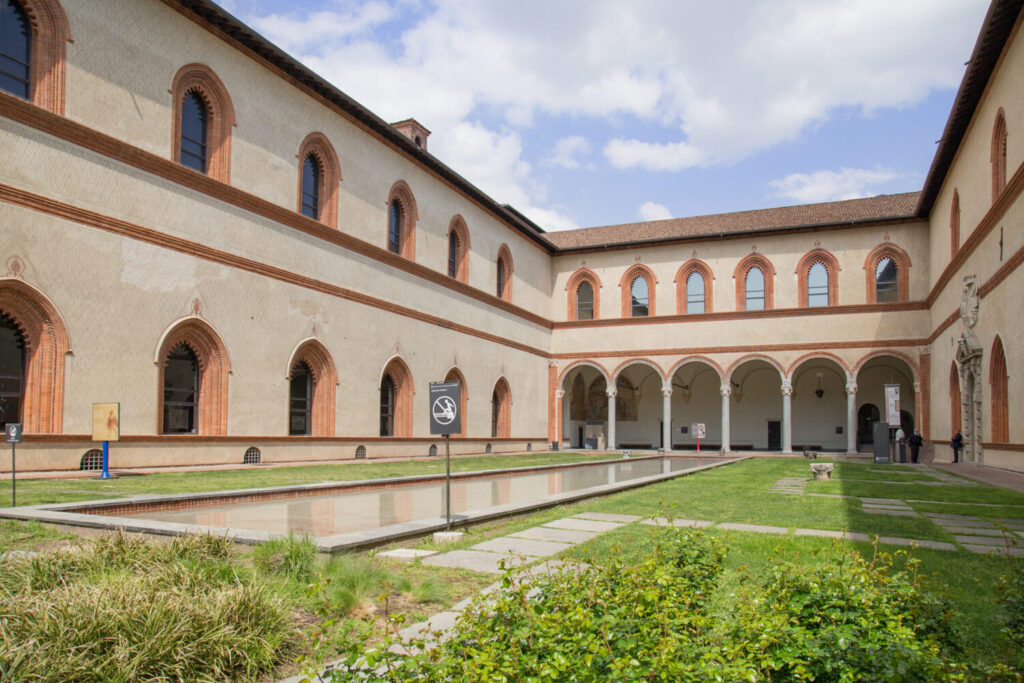
The Ducal Rooms of Sforza Castle: Discover the Historic Residence of the Sforza Family
Walking through the ducal apartments of Sforza Castle is like stepping into Renaissance Milan. From 1468, these were the private rooms of Galeazzo Maria Sforza and Bona of Savoy. Today, they are part of the Museum of Ancient Art. The frescoed ceilings, like the one in the Chapel of San Donato with its powerful Resurrection of Christ, reflect the elegance and grandeur of Milanese court life.
One of the highlights is the Sala delle Asse, a masterpiece designed by Leonardo da Vinci for Ludovico il Moro. Its ceiling is painted with an intricate canopy of knotted branches, revealing glimpses of the sky and symbols of Sforza power. In the Sala dei Ducali, decorated with coats of arms and initials of Galeazzo Maria, you’ll notice an evident passion for heraldry in every detail.
The Cappella Ducale features dynamic frescoes of the Resurrection, with expressive guards at the tomb in vivid, almost theatrical poses. The Sala degli Scarlioni, named for its red and white zigzag pattern, once hosted audiences and secret councils.
In the Sala del Tesoro, inside the Castellana Tower, don’t miss Bramantino’s fresco of Argus with a hundred eyes. He’s the symbolic guardian of the duke’s treasure. Finally, La Ponticella is a small elevated loggia over the moat, where Ludovico il Moro retreated in mourning after the death of his wife Beatrice d’Este. Its three rooms are still known as the Black Rooms, a quiet echo of that sorrow.
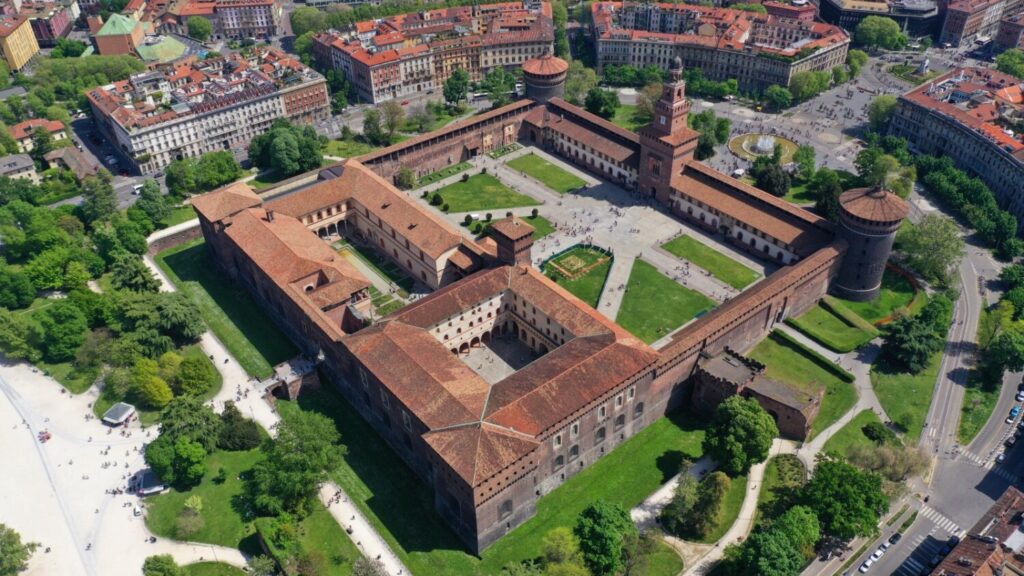
Towers, Battlements and Underground Passages: Explore the Medieval Side of Sforza Castle
The towers of Sforza Castle aren’t just impressive military structures. They tell stories of power, courtly life and Renaissance artistry. Every corner of the fortress reveals something about its rich and layered past.
The Torre del Filarete is the Castle’s most iconic feature. Originally built in 1452 and rebuilt in 1905 by Luca Beltrami, it showcases symbols of the Sforza family, including their coat of arms and a statue of Saint Ambrose, Milan’s patron saint.
The Torre di Bona, built by Bona of Savoy after her husband’s assassination, served both as a personal refuge and a prison. You can still see a small cell with its peephole. With their vaulted chambers, the massive Torrioni di Santo Spirito e del Carmine once housed the Castle’s main dungeons.
Inside the Torre Castellana, you’ll find the Sala del Tesoro, featuring Bramantino’s striking fresco of Argus, the mythological guardian with a hundred eyes. On the opposite side, the Torre Falconiera houses Leonardo da Vinci’s Sala delle Asse.
The battlements and elevated walkways were carefully reconstructed by Beltrami to match the Castle’s original appearance based on historical records. And don’t miss the Strada Coperta. It was a hidden passage at the moat level once used by soldiers to move unseen.
The Museums of Milan’s Sforza Castle: Art, History and Culture with One Ticket
Sforza Castle is home to seven museums accessible with a single ticket. Therefore, it’s the perfect opportunity to dive into centuries of art, history and culture. From Michelangelo’s final masterpiece, the Pietà Rondanini, to rare musical instruments, frescoes, historical armour, and rooms once decorated by Leonardo da Vinci, every corner of the Castle offers something fascinating.

Michelangelo’s Pietà Rondanini Museum
Housed in the former Spanish Hospital, this museum is entirely dedicated to Michelangelo’s final, unfinished sculpture: the Pietà Rondanini.
The Virgin tenderly supports Christ’s lifeless body in a profoundly moving and emotional scene. The minimalist layout enhances the sculpture’s dramatic impact, creating an intimate and contemplative atmosphere.
Museum of Ancient Art and Armoury
The Museum of Ancient Art tells over a thousand years of history. Its remarkable collection of sculptures, frescoes, and decorative objects will guide you from the 5th to the 16th century. Highlights include the Funerary Monument to Gaston de Foix and the stunning Sala delle Asse, painted by Leonardo da Vinci for Ludovico il Moro. The Armoury at the end of the visit, displays an impressive array of historical weapons and armour.
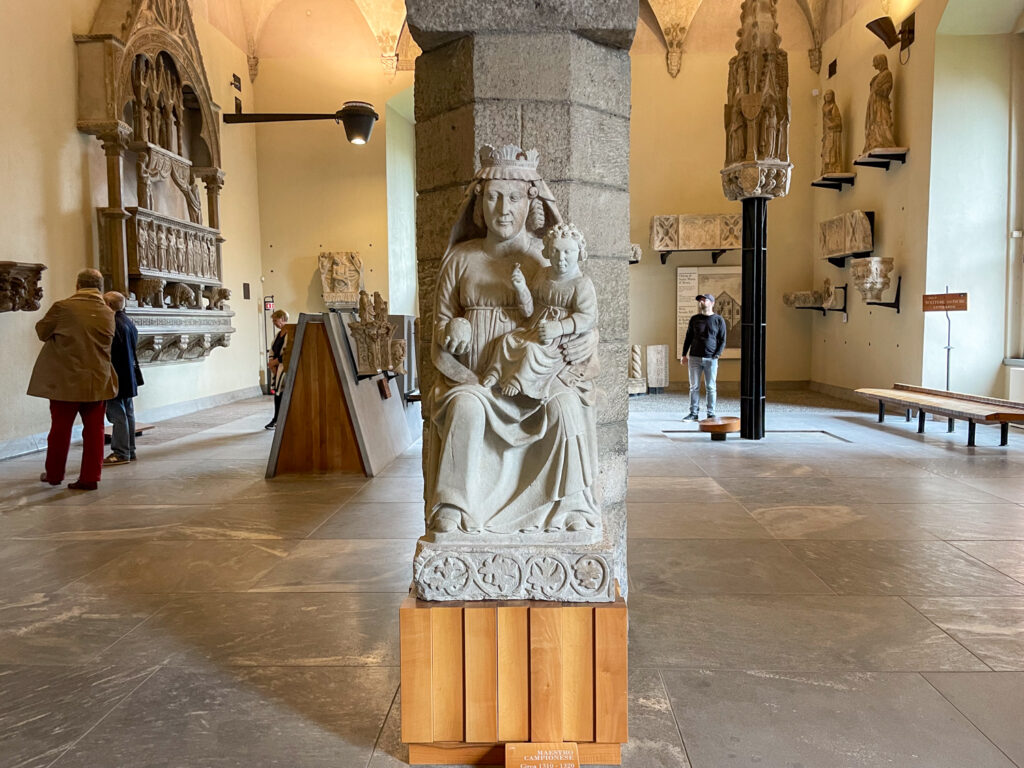
Museum of Furniture and Wooden Sculpture
Located on the first floor of the Ducal Court, the Museum of Furniture and Wooden Sculpture showcases six centuries of craftsmanship from the 15th to the 20th century. This museum’s chronological layout makes it especially fascinating. In fact, it allows you to follow the evolution of taste and style over time. The collection emphasises Lombard traditions, offering insight into the region’s unique approach to furniture design and wood carving.
Art Gallery (Pinacoteca)
The Pinacoteca at the Sforza Castle features an impressive collection of Milanese and Lombard paintings from the 15th to the 18th century, complemented by notable Venetian and Flemish works. Among the artists on display are Mantegna, Bellini, Tiepolo, and Canaletto. The gallery’s rich collection results from donations and acquisitions that have helped preserve and enhance Milan’s artistic heritage.
Museum of Decorative Arts
The Museum of Decorative Arts traces the evolution of taste and style from ancient times to the 1950s. You can admire finely crafted ceramics, glassware, textiles, ivory pieces, and metalwork. The collection highlights how applied arts changed alongside shifting trends. Therefore, you can dive into daily life, craftsmanship, and design across different historical periods.
Museum of Musical Instruments
The Museum of Musical Instruments takes you on a journey through the world of music with over 700 European instruments, from violins and flutes to pianos. While it may not be as large as the Museum of Musical Instruments in Brussels, Milan’s collection also includes unique pieces from Africa, China, Japan, and Australia.
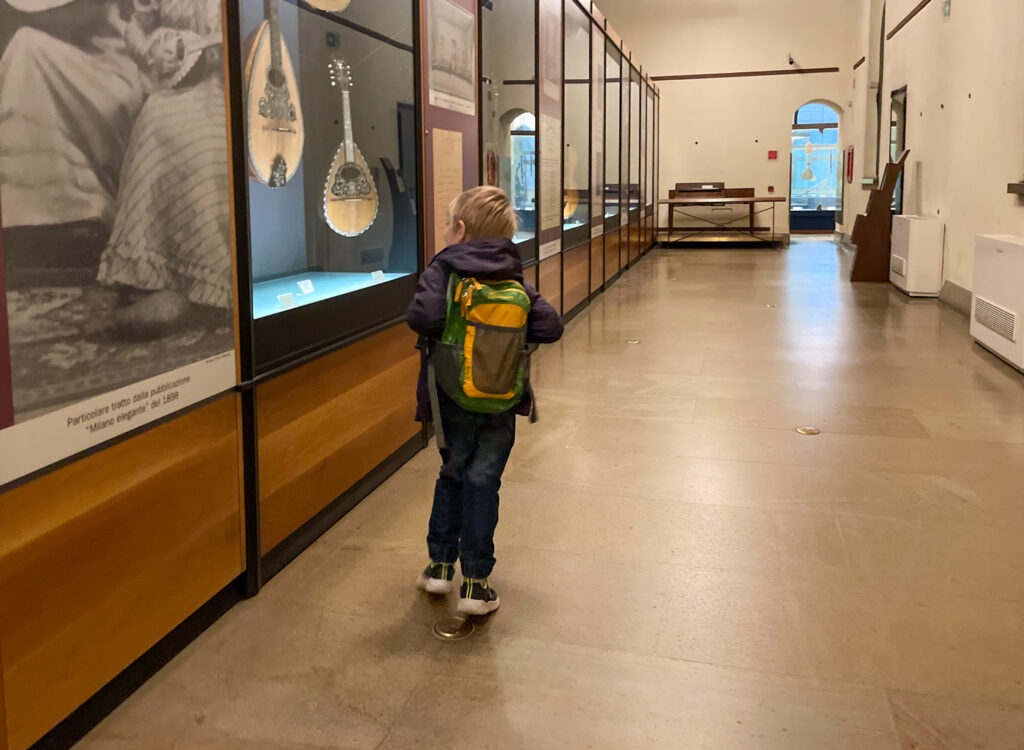
Archaeological Museum
The Prehistory and Protohistory section of the Archaeological Museum at Sforza Castle showcases stone tools, ceramics, and everyday objects. These finds, mostly from Lombardy, reveal how the first hunter-gatherer and farming communities lived. The museum also includes an Egyptian Section, which is currently being reorganised and is temporarily closed.
What to See Around Sforza Castle: A Guide to Parco Sempione
After your visit to Sforza Castle, I recommend a stroll through Parco Sempione, Milan’s large green lung right behind the Castle. Created in the late 19th century on the site of the old ducal park, it’s now an ideal spot to relax among ancient trees, well-kept paths, and scenic views. Here you can admire iconic Milanese landmarks such as the Arch of Peace, the Aquarium, and the Branca Tower.
The Ducal “Barcho”: The History of Parco Sempione and the Sforza Hunts
The Parco Sempione you see today originated from an ancient area known as the ducal “barcho“, established by Gian Galeazzo Visconti at the end of the 14th century.
This vast space north of the Castle was half garden, half farmland. Francesco Sforza enclosed it and stocked it with game animals brought from around Lake Como, like deer, pheasants, and hares. There was also a fishpond, an orchard, and cultivated fields.
During the time of Ludovico il Moro, even Leonardo da Vinci organised parties in this park. After the fall of the Sforzas, the area was abandoned and turned into a military parade ground.
Milan’s English-Style Garden: Parco Sempione Between Nature and Art
At the end of the 19th century, when the Castle was saved from demolition, the municipality decided to create a new urban park. The architect Emilio Alemagna then created an English-style garden between with gentle hills, trees arranged as if in the countryside, streams, and carriage drives.
The layout ideally linked Sforza Castle with the Arena Civica and the Arco della Pace, symbols of 19th-century Milan. Today, the park covers 47 hectares and is enriched with statues and monuments, making it one of the favourite spots for Milanese to stroll and relax.
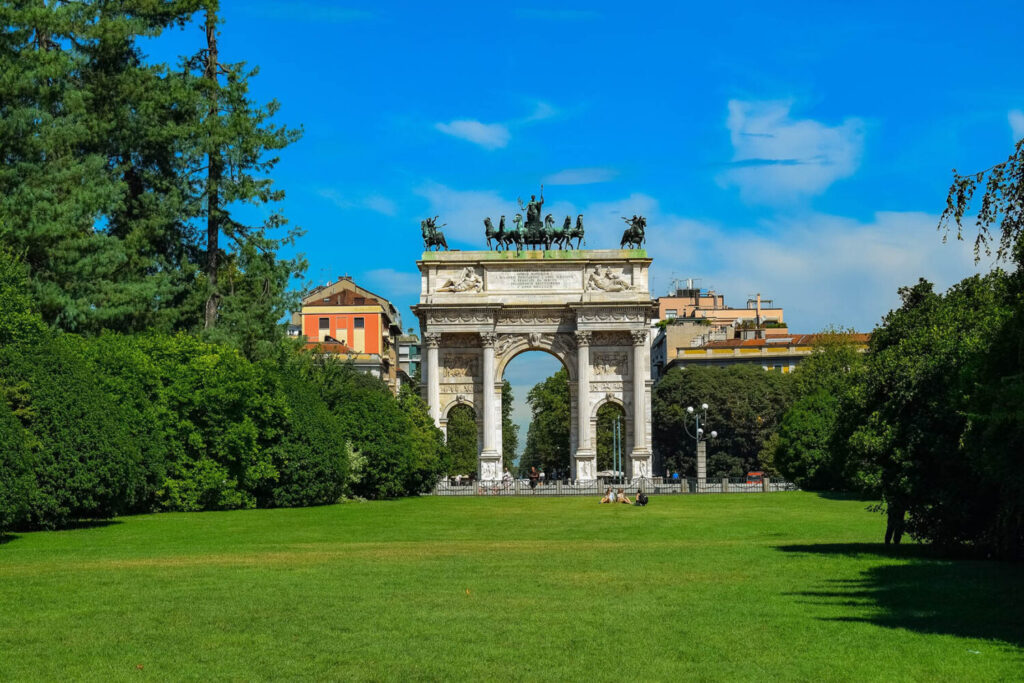
Historic Buildings in Parco Sempione: Architecture and Culture in Milan
While wandering through Parco Sempione, you’ll come across some real architectural and cultural gems. The park is perfect to explore during a day out in Milan.
The Arena Civica, built in 1806, is a large neoclassical amphitheatre that could hold up to 30,000 spectators. Constructed using materials from the old Castle fortifications, it was inaugurated by Napoleon. Over the years, the Arena Civica has hosted incredible spectacles, including naumachiae, actual naval battles staged with water from the Naviglio canal.
Not far from there, the Civic Aquarium, with its stunning Liberty-style facade decorated with floral motifs, is the third oldest aquarium in Europe. Opened in 1906 for the Universal Exhibition, it features tanks filled with freshwater and marine species—mostly Italian—and is an ideal family-friendly destination.
The Palazzo dell’Arte, now home to Milan’s Triennale, was built between 1931 and 1933 to host decorative arts exhibitions. Its clean, modern design makes it instantly recognisable. Here, you can enjoy design, contemporary art, and architecture exhibitions.
If you want to admire Milan from above, climb the Torre Branca. Standing 108 metres tall, it was designed by Gio Ponti and built in just two months in 1933. After years of closure, it was restored by the Branca family, who gave it its current name. Today, it’s open to the public again, and on clear days, the view from the top stretches all the way to the Alps.
Monuments in Parco Sempione: Stories and Symbols in Milan’s Green Heart
Within Parco Sempione, you’ll find several monuments that tell the story of Milan. One of the most striking is the Fontana dei Bagni Misteriosi (Fountain of the Mysterious Baths), a large sculpture by Giorgio De Chirico created in 1973 for the Triennale. Its enigmatic figures, set within a winding basin, create a surreal atmosphere. Some original statues have been moved to the Museo del Novecento for preservation.
The Ponte delle Sirenette (Mermaids Bridge), considered Italy’s first cast-iron bridge and decorated with four mermaids, was originally inaugurated in 1842 over the Naviglio canal before being relocated to Parco Sempione in 1930.
Finally, perched on a small hill, you’ll find the Monument to Napoleon III, commemorating the entry of the French army into Milan in 1859. The equestrian statue and detailed bas-reliefs celebrate the Battle of Magenta and key figures from that historic era.
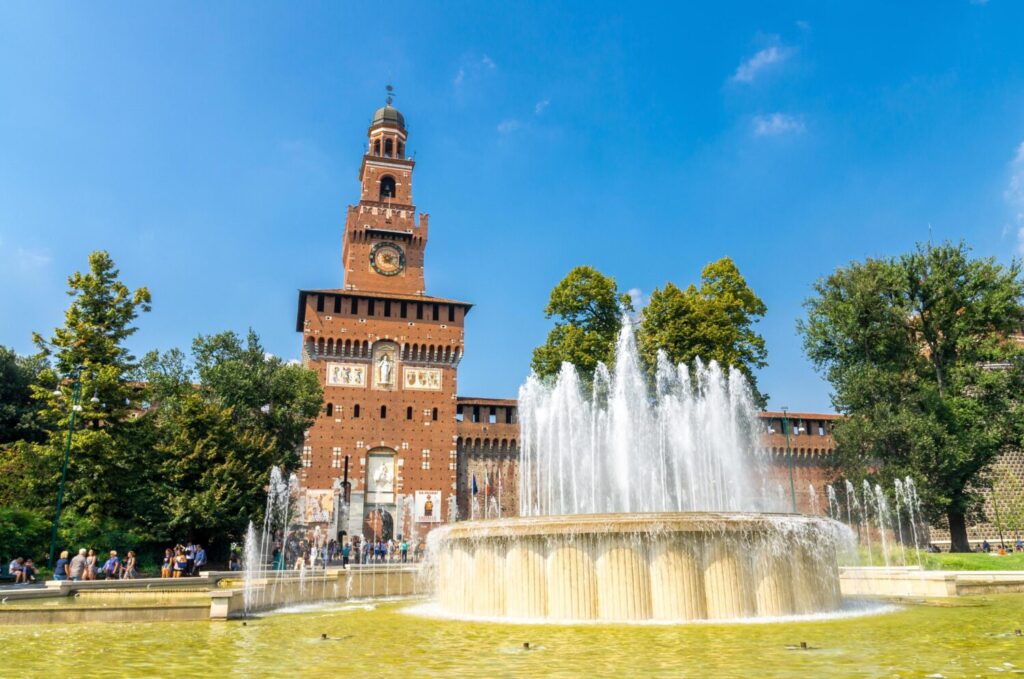
Sforza Castle in Milan: Opening Hours, Tickets and How to Get There
How long your visit to the Sforza Castle lasts depends on what you want to see. If you just fancy a stroll around the courtyards, admiring the towers, battlements, and the Castle’s exterior, you’ll need about 30 to 45 minutes. But if you decide to explore one or more museums inside, plan on spending at least 2 to 3 hours.
When I visited with my son, we wandered through the various rooms and courtyards, stopping only at the things that really caught our interest. Even like that, we managed to see a lot in a couple of hours without feeling rushed.
However, if you’re visiting alone and want a fuller experience, including temporary exhibitions, I’d recommend setting aside 3 to 4 hours. Some exhibitions are really well curated, and it’s worth taking your time to explore them properly.
Also, check the official Castello Sforzesco website for the events calendar. In the summer, for example, festivals, concerts, and outdoor cultural activities can make your visit even more special.
Ticket Prices for Sforza Castle
Entrance to the outer courtyards of Sforza Castle is free, so you can explore these areas without purchasing a ticket. However, to access the museums inside, you’ll need to buy a single ticket that grants entry to all the permanent collections within the Castle.
A full-price ticket costs €5, while the reduced ticket, priced at €3, is available for over 65, young people up to 25, and students. Children and teenagers up to 18 years old enter for free. Additionally, admission is free for everyone on the first and third Tuesday of each month from 2:00 pm onwards.
If you want to get more from your visit and dive deeper into the museums’ exhibitions, consider booking an audio guide or joining a guided tour, especially one that includes the Pietà Rondanini.
Opening Hours of Sforza Castle
The museums inside Sforza Castle are open from Tuesday to Sunday, from 10:00 am to 5:30 pm, with the last admission allowed at 5:00 pm. They are closed on Mondays.
If you just want to stroll through the outer courtyards, you can do so every day, including Mondays, from 7:00 am to 7:30 pm. The courtyards are always free to access and offer a perfect shady spot for a break while enjoying the beauty of central Milan.
How to Get to Sforza Castle
Getting to Sforza Castle in Milan is really easy thanks to excellent transport links. If you’re using public transport, the nearest metro stop is Cairoli on the Red Line (M1). From there, it’s just a few minutes’ walk to the Castle’s main entrance. Trams and buses also stop nearby, making it convenient to reach from anywhere in the city.
If you’re driving, several paid parking lots are close to the Castle. The most convenient ones are near Parco Sempione, so you can enjoy a short, pleasant walk through the park to reach the Castle.
A fun and practical option, especially if it’s your first time in Milan, is the City Sightseeing Hop-On Hop-Off Bus. The bus stops right outside the Castle, letting you get off to explore and then hop back on to continue your sightseeing whenever you want.
Castello Sforzesco
Piazza Castello, 20121 Milano
Where to stay in Milan
Milan is one of Italy’s largest cities and, for this reason, offers every possible type of accommodation. Park Hyatt Milano is the most luxurious hotel in the heart of the fashion district in Milan. It’s near the Cathedral and La Scala Theatre, making it an excellent tourist location. For cheaper yet elegant accommodation, try Aparthotel Meneghino, within walking distance of Milan Cathedral and the Milan Fashion District. B&B Le Dimore Suites Milano is also a great option with a terrace and views of the inner courtyard.
Visiting Sforza Castle is a fascinating journey into the history of Milan, blending art, architecture, and nature. Whether you have just a little time or want to dedicate a whole day, you’ll always find something interesting to discover. Feel free to share in the comments if you enjoyed the visit and have a favourite museum inside Sforza Castle.

10 comments
I am from Milano but, unfortunately, I never appreciated enough the historical meaning of our Sforza Castle. Recently, during a visit of Michelangelo’s Pietà Rondanini I discovered the Museum of Art and I found a lot of master pieces of Lombardia sculpture.
It happens to me the same with Turin! We should be more like tourists in our own city to appreciate it better! 🙂
It is a place much loved by the Milanese too, a must-see if you are in the city and then from here you can walk along the beautiful Via Dante to reach the cathedral
If I lived in Milan, I’d probably spend time around Parco Sempione and Sforza Castle every day!
Being from Milan, I grew up in the shadow of the Castle, which I have always frequented as well as the Sempione Park. But in all these years I still haven’t managed to visit its museums!
Then you won’t be surprised by how many museums in Turin I haven’t visited yet!
I haven’t been able to visit Milan yet, I’ve always had quick stops at the train station, never having time to take a tour of the city. I hope to be able to see its wonders soon, perhaps starting right from the Sforza Castle.
I experienced the same thing! For years, I only made quick stops in Milan for work and never actually took the time to explore the city. Then I decided to go on a staycation and visit Milan intentionally to finally discover it, and it was definitely worth it!
I have been to Milan many times but I have never visited the Sforza Castle, yet it is so central. It’s probably because when you frequent a city so much you take it for granted, I’ll have to organize it
Exactly. It happened to me as well! I have always travelled to Milan for work and have never had the chance to explore the Duomo or the Sforza Castle until I decided to play tourist!